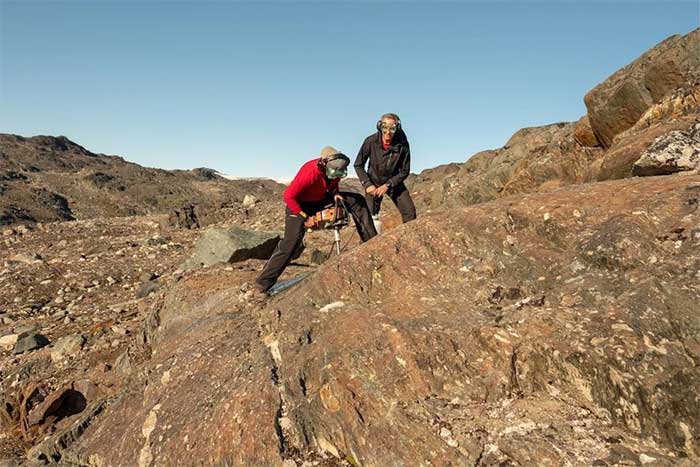The 'armor' that covered the Earth 3.7 billion years ago was revealed in Greenland
An extremely important event for our existence on Earth has been saved in ancient stone tablets .
According to Sci-News, a team of geologists led by the Massachusetts Institute of Technology (MIT - USA) and Oxford University (UK) have found the oldest evidence of the formation of the Earth's magnetic field in rocks. ancient part of the Isua Supercell Belt in West Greenland.
The Isua supercrust belt in West Greenland has experienced three thermal events throughout its geologic history.

Geologists are drilling ancient rocks in West Greenland to search for evidence of Earth's oldest magnetosphere - (Photo: MIT NEWS).
Of these, the first event is the most important, when rocks were heated up to 550 degrees Celsius about 3.7 billion years ago. That is how the ancient Earth generated its own magnetic field.
Earth's magnetic field is created when molten iron in the outer core mixes with liquid, driven by buoyancy as the inner core solidifies, creating a giant "dynamo".
This process causes the initially bare Earth to gain an invisible layer of armor called the magnetosphere.
The magnetosphere protects the planet's surface from the solar wind, which has increased over time. Thanks to this protective layer, life can move onto the continents and leave the protection of the oceans.
For example, a planet next to us, Mars, is located in the "life zone" of the Solar System, but its magnetosphere is too thin and weak, not enough to prevent harmful cosmic radiation. Therefore, Mars currently has no Earth-like life.
Paleomagnetic data in rocks in West Greenland also revealed that the magnetic field 3.7 billion years ago had a strength of at least 15 microteslas. For comparison, the Earth's magnetic field currently has a strength of 30 microtesla.
These results provide the oldest estimate of Earth's magnetic field strength derived from an entire rock sample, providing a more accurate and reliable assessment than previous studies using individual crystals. odd.
'This is a really important step forward as we try to determine the role of ancient magnetic fields when life on Earth first appeared' - Professor Claire Nichols from Oxford University (UK), member research team, said.
A significant challenge in reconstructing Earth's magnetic field so far is that any event that heats rocks can alter previously preserved signals.
Rocks in the Earth's crust also often have long and complex geological histories, erasing previous magnetic information.
However, the Isua Supracrustal Belt has unique geology, located on a thick continental crust that protects it from tectonic activity and widespread deformation, thus preserving the integrity of paleomagnetic data.
This data comes from iron particles in the rock, which effectively act as tiny magnets that can record both the strength and direction of magnetic fields as the crystallization process locks them in place.
The results also provide new insights into the role of the magnetic field in shaping the evolution of Earth's atmosphere.
The magnetosphere helps regulate the planet's atmosphere by pushing certain gases out into space and preventing the loss of essential ones, helping to maintain balance in the atmosphere, which is also essential. other essential for life.
- Half-billion-year-old 'zombie' burrows into the Earth's heart, trapped between diamonds
- See millions of years old radio stations under the Greenland ice sheet
- Why is Greenland covered by ice?
- Greenland Sharks: The key to the longevity of humanity in the future?
- Find the oldest Earth's crater
- The 'alien' spectacle in the world's largest island
- Greenland's huge freshwater reserve is losing 357 billion tons of ice every year
- The Earth's interior is cooling faster than expected
- Art of painting such as photos
- Greenland Island will be completely transformed by 2100
- Earth is belly fat because of climate change
- Greenland lost nearly 200 billion tons of ice in a month
 Discovered an ancient centipede fossil 99 million years old
Discovered an ancient centipede fossil 99 million years old Discovered bat-like dinosaurs in China
Discovered bat-like dinosaurs in China Discovered a 200-year-old bronze cannon of the coast
Discovered a 200-year-old bronze cannon of the coast Discover 305 million-year-old spider fossils
Discover 305 million-year-old spider fossils